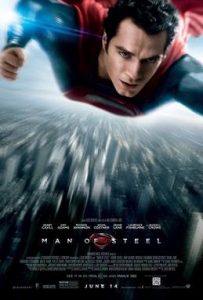
(SFX Magazine, Future Publishing)
Beginnings are important, especially for superheroes. But endings, arguably, matter more. A lot of viewers took against the end of Man of Steel. Partly it was the perversity of showing one huge battle, then revving up another huge battle just seconds later. There was also the emphasis on demolition porn, and Superman’s apparent carelessness about the lives of spare civilians. Weirdly, the final Kryptonian punch-out has the mentality of modern drone warfare – a very contemporary Superman.
Another factor, perhaps, was the last battles’ emphasis on hulking, pulverising machines. Audiences come to a Superman film to see super people, not super mecha. Oddly, another of this year’s films, Pacific Rim, showed how you could smash cities with big machines and still imbue the spectacle with humanity.
Some fans complained about the end because of a terrible choice Superman makes. Yes, it may run against Superman lore – but then this is a film where Lois Lane always knows Clark Kent is Superman, so lore is out of the window anyway. Superman’s choice is also consistent with his backstory. When he saves his classmates from a sinking bus, his human father (Kevin Costner) suggests he should have “maybe” let them die, for the greater good. For Clark, and for most humans, that would have been impossible. The end similarly stresses Superman’s humanity, in an impossible situation.
Man of Steel, though, starts by stressing Superman’s alien nature, more than any other screen version of the character. The prologue is a hugely enjoyable post-Avatar space opera, complete with flying steeds and alien tech. Everything on Krypton seems to run on liquid metal. The Earth scenes draw on The Thing (the arctic adventure, where Lois meets Clark as a red-eyed monster in an ice cave) and The Day the Earth Stood Still (the superb sequence where Zod invades the world’s tellies to proclaim “You Are Not Alone”). Most inspired, though, is a sudden dash of fantasy. Russell Crowe recaps Krypton’s history through frieze-like animation, perhaps inspired by the shadow puppets in Harry Potter and the Deathly Hallows.
Actually, the first hour of Man of Steel is pretty splendid through and through, both in its vision and its emotion. When Clark visits home and tells Ma Kent (Diane Lane) that he knows where he’s really from, her heartbreak is exquisite. The no-nonsense introduction of Amy Adams’ Lois Lane’s is equally pitch-perfect. Her toughness is in line with Lois in Superman’s early days, though back then she might not have been quite as blunt with army brass. “If we’re done measuring dicks…”
It’s in the second hour, when it becomes clear how different this film is, that doubts arise. Zack Snyder’s Superman just seems to have thrown out too much bathwater from earlier versions. Without any time-outs in the Daily Planet, no time for banter or screwball comedy, there’s little room for rounded relationships.
In particular, Lois and Clark never click as a pair. When Clark cauterises Lois’s wound with his heat vision, it’s agonising, but it’s hardly a romantic gesture. We miss the famous mid-air catch from the 1978 film (with Margot Kidder’s zinger, “You’ve got me… Who’s got you?”). In the adversary’s corner, Michael Shannon’s Zod makes perfect plot sense – even his revenge spree has a speech to rationalise it – but his power feels stiff and impersonal. There’s a reason why Superman II gave Zod campy lines and sidekicks.
The film’s main wonder, and Zack Snyder’s lasting achievement, is in letting us be Superman like never before: from the child Clark’s terrifying acquisition of super-sense in the classroom, to his exultant first flight, a test pilot in his own body. But it’s only in the very last scene that we glimpse Clark Kent the roving reporter and man around Metropolis. The net may be lit up about Supe’s co-star next time, but let’s hope the sequel has time for the guy in glasses.
